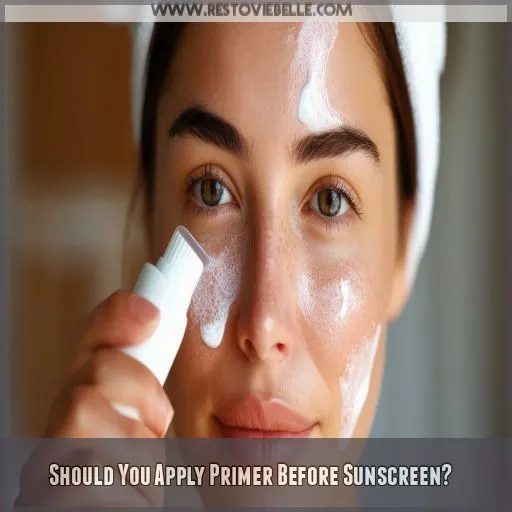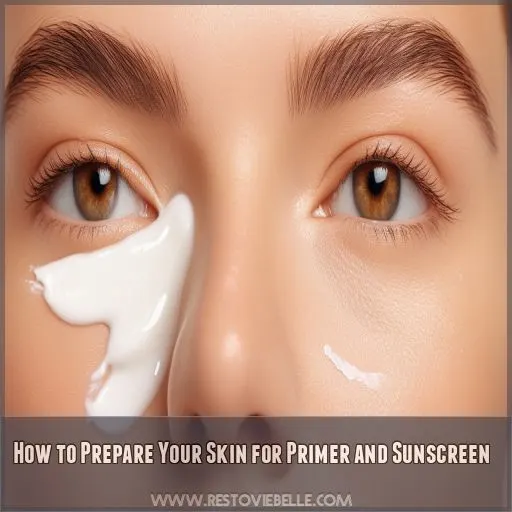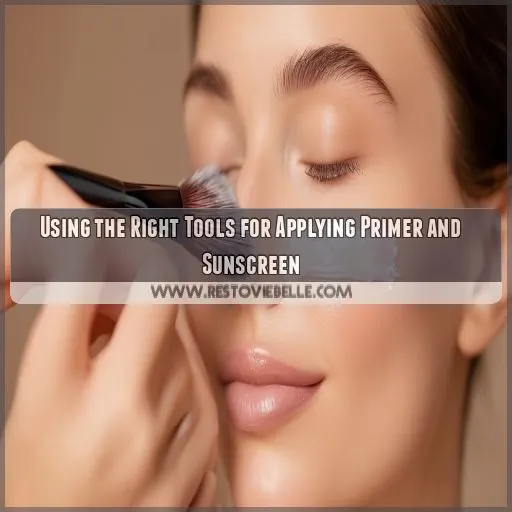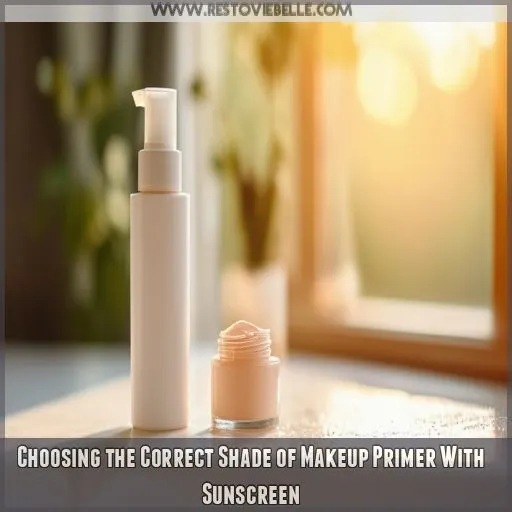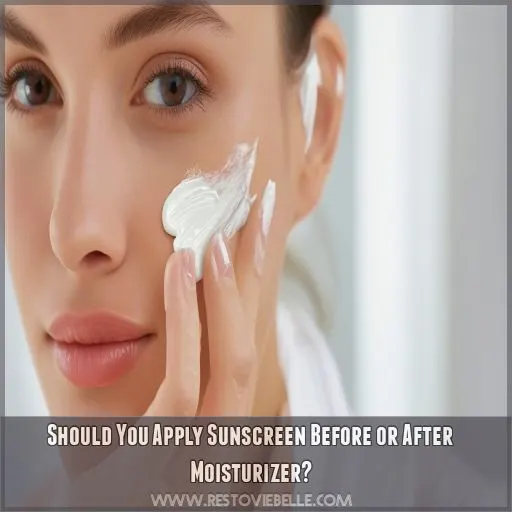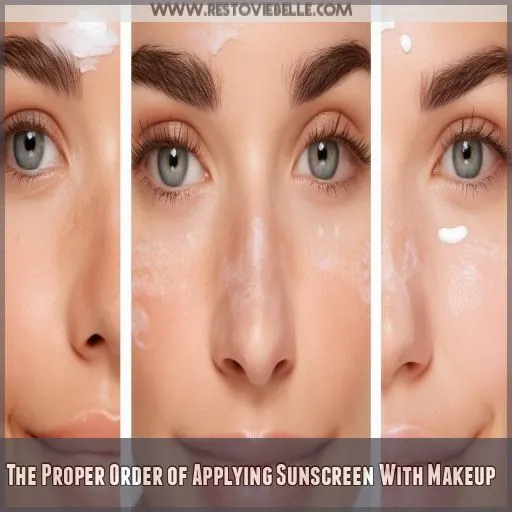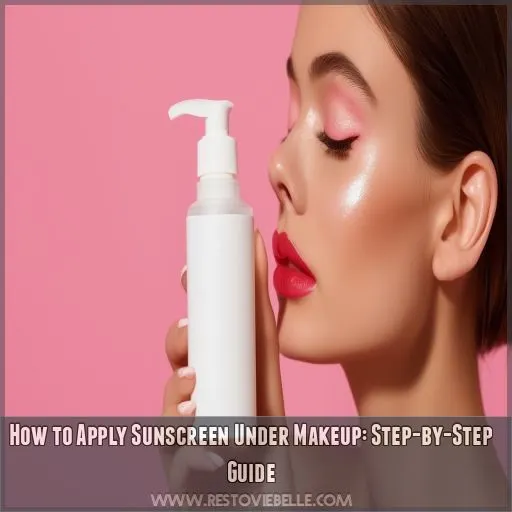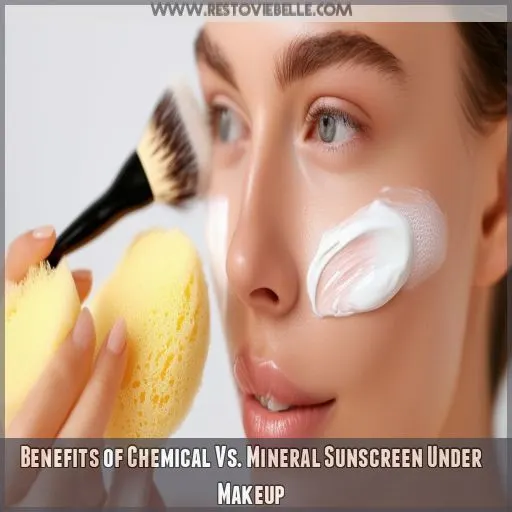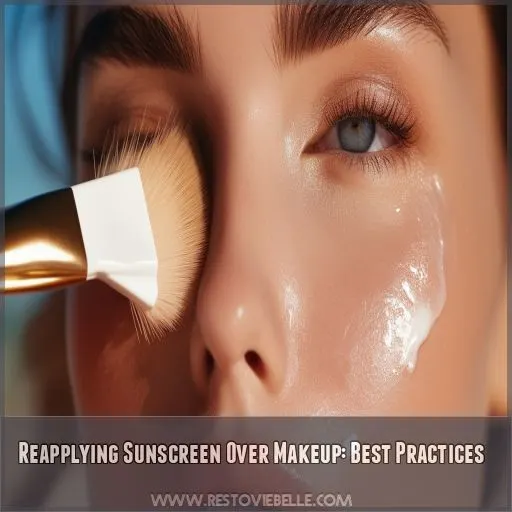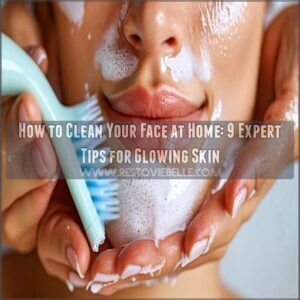This site is supported by our readers. We may earn a commission, at no cost to you, if you purchase through links.
 Imagine the smooth glow of your skin, perfectly prepped for makeup, protecting it from harmful sun rays. Do you apply a primer or sunscreen first? Yes, the answer does matter for flawless application and effective protection.
Imagine the smooth glow of your skin, perfectly prepped for makeup, protecting it from harmful sun rays. Do you apply a primer or sunscreen first? Yes, the answer does matter for flawless application and effective protection.
This detailed guide shall ensure that your skincare and makeup routine blend perfectly, like hand in glove, by explaining the order. We’re going to examine every step with clear instructions on how you can layer the products precisely for optimal results.
Master your routine with the best practices of this all-inclusive article.
Table Of Contents
- Key Takeaways
- Do You Apply Primer or Sunscreen First?
- Should You Apply Primer Before Sunscreen?
- How to Prepare Your Skin for Primer and Sunscreen
- Using the Right Tools for Applying Primer and Sunscreen
- Choosing the Correct Shade of Makeup Primer With Sunscreen
- Should You Apply Sunscreen Before or After Moisturizer?
- The Proper Order of Applying Sunscreen With Makeup
- How to Apply Sunscreen Under Makeup: Step-by-Step Guide
- Benefits of Chemical Vs. Mineral Sunscreen Under Makeup
- Reapplying Sunscreen Over Makeup: Best Practices
- Frequently Asked Questions (FAQs)
- Does sunscreen go on before or after primer?
- What goes first primer or moisturizer with SPF?
- What order to put sunscreen on face?
- How long should you let primer dry before foundation?
- Can primer replace sunscreen entirely?
- How long should I wait between primer and sunscreen?
- Will sunscreen affect the longevity of my makeup?
- Are there any ingredients to avoid in combined products?
- Can I mix primer and sunscreen before applying?
- Conclusion
Key Takeaways
- Sunscreen before primer? You betcha! Slather on that SPF first to shield your skin from those sneaky UV rays. It’s like putting on your armor before heading into battle – protection comes first!
- Patience is a virtue, especially when it comes to your beauty routine. Give your sunscreen 15-30 minutes to soak in before primer time. Think of it as a mini spa moment – breathe, relax, and let that SPF work its magic.
- Don’t skimp on reapplication! Even with makeup on, you’ve gotta keep that sun protection going strong. Powder sunscreens are your new BFF for touch-ups without messing up your flawless face.
- Remember, primer isn’t a sunscreen substitute. It’s like expecting your sidekick to be the superhero – they’re great support, but sunscreen is the real MVP in protecting your skin from harmful rays.
Do You Apply Primer or Sunscreen First?
The real question here, though, is "Do you apply primer or sunscreen first?" The answer to that is quite clear: sunscreen first.
Cleanse your skin, moisturize, and slather on some generous helpings of sunscreen. Wait 15-30 minutes for its complete absorption before applying primer. This order allows for maximum sun protection with a silky base for your makeup.
Oh, yeah! And certainly the most important among all—sunscreen! Either is going to apply nice and evenly with the right tools at hand—like a makeup sponge or brush.
This routine will give you blemish-free makeup while keeping your skin safely protected from ultraviolet radiation.
Stay tuned for more tips from the pros to help you perfect that beauty routine of yours.
Should You Apply Primer Before Sunscreen?
Now, when it comes to how to wear primer and sunscreen together, sunscreen should go first. This way, you provide maximum protection from the sun, and then the primer will help create an even base for your makeup.
Apply sunscreen on clean skin and give it some time to absorb into your skin – 15-30 minutes depending on the consistency, so that pilling doesn’t occur (Source). Allow it to dry, then apply a primer according to your skin type to give you that flawless, poreless finish, extending the wear of your makeup just a little more.
Primer-based formulas are available across all textures to provide more specific needs, whether that may be controlling oil or providing hydration (Source). Remember, coverage of makeup primer doesn’t replace sun protection.
In addition, one always wears sunscreen and reapplies SPF every two hours if continuous protection is required (Source).
How to Prepare Your Skin for Primer and Sunscreen
Before applying primer and sunscreen, be sure to cleanse and moisturize your skin. Properly preparing your skin will help the products apply smoothly and maximize their benefits.
Cleansing and Moisturizing
Start with clean skin by using a gentle cleanser. Tailor your cleansing routine according to your skin type. Follow up with the right moisturizer to hydrate your skin. Good skin care and prepping mean an even application of primer and sunscreen for healthier skin and longer-lasting makeup.
Benefits of Prepping Skin
It’s important to prepare your skin for both primer and sunscreen applications to achieve flawless results. Here’s why:
- Cleansing ensures a fresh start for smooth primer application.
- Moisturizing holds in hydration that will help primer formulation blend out seamlessly.
- Prepped skin has thus improved primer consistency at the behest of an even base and radiant complexion.
A well-prepped face allows for primer and sunscreen to stick in properly, prolonging the life of your makeup.
Using the Right Tools for Applying Primer and Sunscreen
When talking about primers and sunscreen tools, the right tool makes half the battle. Begin with a fresh, well-moisturized face and follow through with a makeup sponge or foundation brush for an even finish.
For primer, a beauty blender ensures velvety-smooth and poreless coverage that’s sure to set up your skin just right for makeup.
Sunscreens should also be applied in a soft and thorough manner. Try using a powder sunscreen brush or a sponge on cream formulas for really good coverage.
Methods of reapplying are equally important: think about products like SPF setting sprays that are infused for easy and on-the-go reapplication without messing up your makeup.
Using these skincare must-haves correctly will ensure ease of performance under your primer and sunscreen layers, both in beauty and protection to your skin, while providing you with a flawless finish all day long.
Choosing the Correct Shade of Makeup Primer With Sunscreen
Choose a make-up primer in the right shade that will offer you desirable SPF. Make it to match your skin color and apply evenly to make your foundation on top of a really nice, even base.
SPF Primer Benefits
SPF primers offer dual benefits for your skin. They help smooth your skin for makeup application and protect it from UVA/UVB rays. Ingredients like antioxidants and hyaluronic acid can enhance hydration and skin health.
Recommendations for the best SPF primers include positive reviews and comparisons with standard sunscreens. Opt for an SPF primer to achieve a natural look with added sun protection. This can help ensure makeup longevity.
Shade Matching Tips
When choosing a primer with SPF, make sure to pick one that’s as close to your skin color as possible so that it doesn’t stand out on your face. Primer coverage varies, so keep skin types and textures in mind.
Go for something that works well, flows good, and enhances your makeup without leaving a white cast, but always keep an eye on its ingredients to accommodate any special needs of your skin.
Application Best Practices
You’ve got the primer equipped with SPF on. Here are some best practices for application:
- Prep Skin: Clean and moisturize beforehand.
- Tools: Beauty blender or a foundation brush.
- Application: Gently dab primer onto your face, avoiding eyes and lips.
- Layering Sunscreen: Let it absorb well before applying primer.
Following these steps ensures a flawless finish!
Should You Apply Sunscreen Before or After Moisturizer?
When you’re wondering which is better to apply first, sunscreen or moisturizer, remember that layering in the right way is necessary. Believe it or not, for quality protection and good general health of your skin, it’s best to slather on sunscreen after moisturizing. Moisturizer pre-games the skin by setting a hydrated base before adding the SPF. This is particularly important if you have certain skin issues such as dryness or little wrinkles.
| Skin Type | Recommended Moisturizer | SPF Rating with the Use of Sunscreen | Reapplication Frequency |
|---|---|---|---|
| Dry | Hydrating, with ceramides | SPF 30+ | As often as every 2 hours |
| Oily | Lightweight, oil-free | SPF 30-50 | Every 2 hours |
| Sensitive Skin | Fragrance-free, Soothin | SPF 50+ | Every 2 hours |
| Combination | Balancing, non-comedogenic | SPF 30-50 | Every 2 hours |
Apply a good sunscreen, such as EltaMD AOX Mist Broad-Spectrum SPF 40. This will ensure that you have sufficient UV protection over your foundation.
The Proper Order of Applying Sunscreen With Makeup
When applying sunscreen and makeup, it’s important to follow the proper order. First, apply sunscreen before any other products, allowing it to fully absorb into the skin. Then, you can apply primer and other makeup as desired, ensuring your skin is protected from harmful UV rays.
Sunscreen Before Makeup
Slather on sunscreen before your makeup. First, cleanse and moisturize the skin, then apply a broad-spectrum sunscreen depending on your skin type and tone. Let it absorb for 15 minutes. Apply Thank Me Later Blurring Face Primer to create an even base. Reapply sunscreen during the day when you’re going out.
Sunscreen After Foundation
Applying sunscreen after foundation can be a bit tricky but possible. Opt for a sunscreen powder to maintain your look. Lightly dust it over your face for added sunscreen coverage without disrupting makeup. Both chemical and mineral sunscreens come in powder form, perfect for quick touch-ups and reapplying sunscreen throughout the day to keep your skin protected.
How to Apply Sunscreen Under Makeup: Step-by-Step Guide
First, cleanse your face thoroughly and apply any necessary serums before moving on to moisturizing your skin. Next, apply your sunscreen and allow it to fully absorb into your skin before starting your makeup routine.
Washing Your Face
Cleanse your face well before applying primer or sunscreen to create a clean base. This would include gentle cleansers to rid the pores of impurities and exfoliants or masks afterward for deeper cleansing.
Toners are used to level out the pH balance of the skin and remove residual dirt.
Adding Serums
After washing your face, it’s time to add serums. Choose the best serums for your skin type—hydrating, anti-aging, or brightening. Apply a few drops of your selected serum types, focusing on serum benefits like boosted hydration and reduced fine lines. Gentle patting aids serum absorption, ensuring active ingredients penetrate deeply. This step prepares skin for further treatments.
Moisturizing Your Skin
After cleansing, it’s time to moisturize your skin. Choose a hydrating formula suited to your skin type – oily, dry, or combination. Gently massage the moisturizer into your face, focusing on areas that need extra hydration. This step preps your skin for the final layer of sunscreen, creating a smooth, even canvas for makeup application.
Applying Sunscreen
To apply sunscreen under makeup, choose between mineral or chemical types. Squeeze out a nickel-sized amount and dot it across your forehead, cheeks, nose, and chin. Gently blend it in, using upward strokes. Don’t forget your neck! For reapplication, use sunscreen powders or sprays to maintain protection without messing up your makeup.
Allowing Sunscreen Absorption
Let your sunscreen get completely absorbed into the skin before applying makeup. It allows maximum UV protection to the skin and gives a very smooth base for makeup. Wait for at least 15 minutes, and in the meanwhile:
- Relax with a cup of tea.
Organize your make-up tools.
- Review your day’s schedule.
- Reflect on your skincare routine.
Proper absorption is the key to work sunblock protection and to get a flawless finish.
Benefits of Chemical Vs. Mineral Sunscreen Under Makeup
Both chemical and mineral formulas have their particular strengths for use under makeup. The active ingredients in chemical sunscreens absorb UVRs, hence making layering a breeze, while the mineral actives of sunscreens block the rays physically and can mattify the skin.
Chemical Sunscreen Advantages
Chemical sunscreens are great for makeup lovers. They absorb quickly into your skin, offer broad-spectrum UV protection, and are perfect for layering under makeup without pilling.
| Benefit | Description | Example Ingredients |
|---|---|---|
| Quick Absorption | Blends seamlessly without residue | Avobenzone, Octocrylene |
| Broad-Spectrum | Protects against UVA and UVB rays | Oxybenzone, Octinoxate |
| Makeup-Friendly | Ideal for smooth application | Homosalate, Octisalate |
This makes them a top choice for busy mornings.
Mineral Sunscreen Benefits
Mineral sunscreen offers superior skin protection by deflecting both UVA and UVB rays. It’s great for sensitive skin as it’s less likely to cause irritation. With broad spectrum coverage, you’ll stay protected throughout the day, and it provides a mattifying effect. Remember, reapplication is key to maintaining its benefits, especially over makeup.
Reapplying Sunscreen Over Makeup: Best Practices
Now that you’ve got the right sunscreen and primer combo, it’s time to talk about reapplying that all-important sun protection throughout the day.
Don’t let those UV rays sneak through – reach for sheer, lightweight sunscreen formulas that won’t leave a dreaded white cast on your made-up complexion.
Gently pat or brush the sunscreen over your makeup using a makeup sponge or fluffy brush.
And for an extra skin-loving boost, look for sunscreens enriched with antioxidants to help rejuvenate and revitalize your radiant look, even as you reapply.
Stay protected and picture-perfect all day long by making sunscreen reapplication a seamless part of your makeup routine.
Frequently Asked Questions (FAQs)
Does sunscreen go on before or after primer?
Since you do that, you’d want to apply sunscreen before applying primer. And of course, that has to come first: protect your skin. Maybe wait for the sunscreen to be fully absorbed in about 15 minutes so that afterward, you can apply your primer. In that order, you gain maximum sun protection and have a smooth base for applying makeup.
What goes first primer or moisturizer with SPF?
Ever wondered what the perfect skincare sequence is? Well, wonder no more because you’re not alone! Moisturize with SPF first, then prime. This will make sure your skin is protected but will also create a really smooth canvas for your makeup. Remember, sunscreen’s your skin’s best friend!
What order to put sunscreen on face?
You’ll want to start with a clean, moisturized face. Apply your sunscreen first, letting it absorb for a few minutes. Then, follow up with your primer before moving on to the rest of your makeup routine.
How long should you let primer dry before foundation?
Groovy, beauty mavens! You’ll want to let your primer dry for about 60 seconds before applying foundation. This allows it to set and create a smooth canvas. If you’re in a rush, gently fan your face to speed up the process.
Can primer replace sunscreen entirely?
No, primer alone won’t be able to substitute sunscreen completely. There are some primers with SPF, but they aren’t actually made for full sun protection. You’ll need a dedicated sunscreen preparation that could provide you with adequate UV defense. Use both for optimal skin care and makeup application.
How long should I wait between primer and sunscreen?
You’ll want to wait about 2-3 minutes between applying sunscreen and primer. This gives your sunscreen time to set and form a protective barrier. Don’t rush it – your skin’s safety is worth the short wait!
Will sunscreen affect the longevity of my makeup?
Sunscreen won’t compromise your makeup’s longevity if applied correctly. It actually helps protect your skin and can enhance makeup wear. Use a lightweight, non-greasy formula and allow it to absorb before applying primer and foundation for best results.
Are there any ingredients to avoid in combined products?
When choosing combined primer-sunscreen products, avoid harsh alcohols, fragrances, and comedogenic ingredients. Look out for potential irritants like oxybenzone or avobenzone. Opt for products with zinc oxide or titanium dioxide for gentler sun protection and skin-friendly formulas.
Can I mix primer and sunscreen before applying?
Ah, the old "mix and match" makeup hack! Sadly, it’s not a good idea to mix primer and sunscreen before applying. They do different jobs and need to apply singly for optimum effect if you want your products to work well. Just stick with layering!
Conclusion
Mastering both primer and sunscreen will definitely work magic on your skin. You already know the answer to "do you apply primer or sunscreen first?" and many tips on how to apply flawlessly in general.
Always remember, sunscreen comes before the primer for maximum protection. If you follow these steps, as guided here, you’ll have the perfect canvas for makeup while keeping your skin safe.
Whether you use a chemical or mineral sunscreen, it’s all about proper application and reapplication. Your skin is going to love this newfound knowledge and care.

